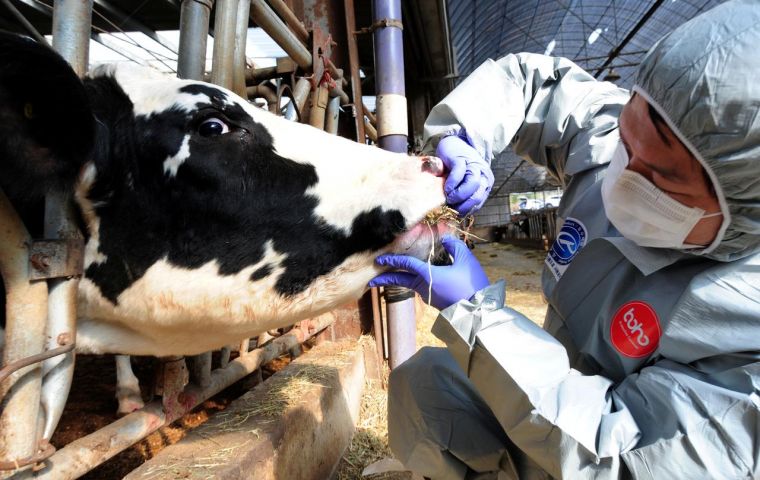MercoPress. South Atlantic News Agency
Foot and mouth disease spreads to the whole of the Korean peninsula
 Sources across three regions of North Korea reported that FMD outbreaks in their respective areas have led to the death of many work cattle on collective farms (Moon Yo-han/Reuters)
Sources across three regions of North Korea reported that FMD outbreaks in their respective areas have led to the death of many work cattle on collective farms (Moon Yo-han/Reuters) In the wake of the South Korean government’s battle to prevent the spread of foot-and-mouth disease following an outbreak in three farmhouses in the cities of Anseong and Chungju earlier this year, North Korean livestock industry insiders have reported that Pyongyang is also struggling with a nationwide spread of the disease outbreak that began in the middle of January.
Multiple sources across three regions of North Korea reported that foot-and-mouth outbreaks in their respective areas have led to the death of many work cattle on collective farms.
During the early stage of the outbreak, it was assumed that the cows had died from malnutrition. But as the number of deaths increased, a veterinary sanitary agency launched an investigation and concluded that it was foot-and-mouth disease.
Foot-and-mouth disease is a type 1 viral, legally-recognized communicable disease that occurs in cloven-hoofed animals such as cows, pigs, goats, dears and camels involving the formation of blisters around the animal’s mouth and feet, with a fatality rate between 5 – 55%.
Foot-and-mouth disease is highly contagious, infecting the respiratory tract and transmitted through the air, with one infected animal sufficient to rapidly infect the rest of the herd. For cows, the incubation period is only 3 to 8 days and once infected, symptoms appear quickly. There is no cure, but tissue culture vaccines are used as a preventive method.
South Korea’s intelligence agency has also received information on the outbreak in North Korea and is monitoring the spread of the disease and the country’s response. Foot-and-mouse disease can spread through the air, and if it reaches the border region, the South Korean authorities will have to enact measures to deal with it.
When a foot-and-mouth disease outbreak is detected in South Korea, a nationwide ban on the transport of all cloven-hoofed animals is issued and livestock in farms around the outbreak are preventatively culled.
When the disease first emerged this winter in Anseong, the South Korean Ministry of Agriculture conducted a nationwide vaccination of all cows and carried out disinfection measures focusing on livestock farms and transportation routes.
North Korea also quarantines outbreaks of foot-and-mouth disease and announces measures for disinfection and cure. Pig and cow carcasses are buried and cloven-hoofed animals are banned from sale in the markets.
However, the vast majority of collective farms lack appropriate supplies such as disinfectants and quicklime. They also lack an understanding of the disease itself and frequently expect the disease to resolve itself naturally while in quarantine.




Top Comments
Disclaimer & comment rulesCommenting for this story is now closed.
If you have a Facebook account, become a fan and comment on our Facebook Page!